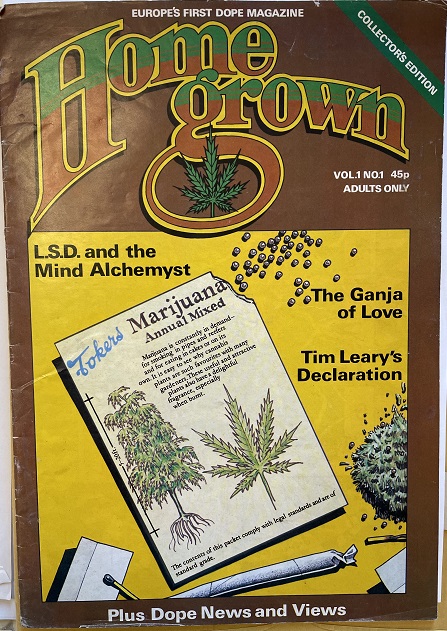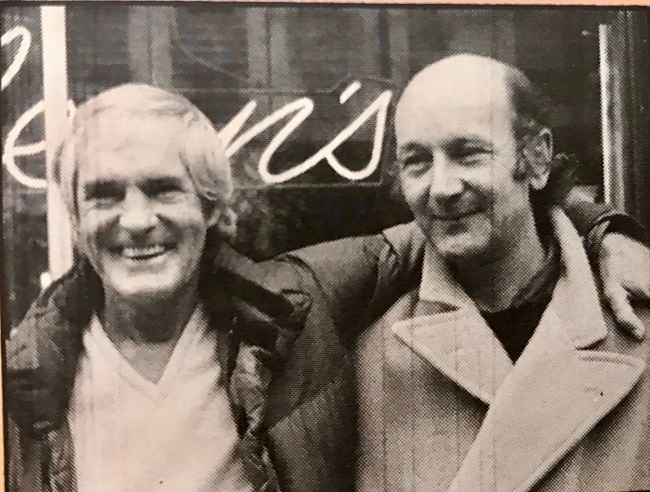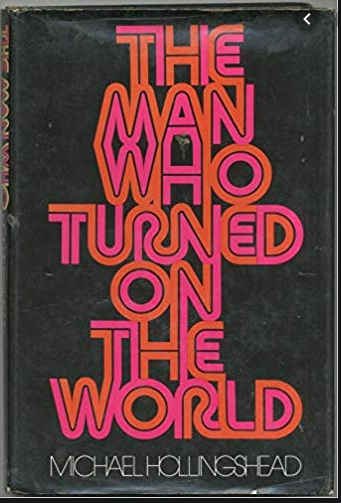

1970

IN 1961, a mysterious Englishman surfaced in Cambridge, Massachusetts, equipped with a mayonnaise jar full of LSD-infused sugar paste. The 16-ounce jar, safely stored in Michael Hollingshead’s luggage, was rumored to contain no less than 5,000 potential trips. After befriending Timothy Leary, Hollingshead promptly moved into his attic and proceeded to take the Harvard psychologist on his first LSD trip in December 1961.
There was a time in the late fifties and early sixties when dope was something that the ‘beats’ and ‘spades’ took. ‘Taking acid’ had not become the popular pastime of a tuned-on youth, for they didn’t exist.
It was in this rather drab and dreary period, which suffered from the after-effects of the Cold War, that L.S.D. first emerged on the social scene in America. Such writers as Aldous Huxley and Gerald Heard had used it with quite astonishing results, for in those days it was legal, though not easily available.
In 1960 a young Englishman, Michael Hollingshead, who happened to be living and working in New York at the time, telephoned Huxley at his home in Los Angeles to inquire about obtaining some mescaline. During the conversation, Huxley mentioned L.S.D. and a caution: “It is much more potent than mescaline.” Huxley’s information included the name of Dr. Albert Hoffman, the Swiss biochemist working at the Sandoz Pharmaceutical Laboratories in Basel, who discovered L.S.D. 25 — by chance — in 1943.
Michael simply asked an English doctor friend to write the order on a New York hospital letterhead, saying he needed the ergot-derivative as a ‘control-drug’ for a series of bone marrow experiments.
A LOVIN’SPOONFUL
A small package from Switzerland arrived in his mail one morning containing one gram of Dr. Hoffman’s acid and a bill for 285 dollars. It was in a small dark jar marked “Lot no. H-00047” and looked a bit like malted milk powder. Michael poured some distilled water in a bowl, then dissolved the acid into it, adding icing sugar into the mixture to make a thick paste. He then transferred his ‘divine confection’ spoon by spoon into a large mayonnaise jar. By some alchemic process the stuff measured exactly 5,000 spoonfuls. Like all good chefs, he’d tasted the preparation with his fingers and absorbed about the equivalent of five heavy doses before he had finished. What followed, lasting perhaps some 15 hours, was an experience that would change Michael’s life, and that of countless others with far-reaching effect.
After that first ‘trip’, Michael once more phoned Huxley to discuss his visionary experience. Huxley called him back a few days later and suggested that he contact a Dr. Timothy Leary, a Harvard professor, who had recently presented a paper on induced visionary experience. “If there is any one single investigator in America* worth seeing, it is Dr. Leary,” said Huxley.
In September 1961, Michael met, and subsequently moved into the home of Timothy Leary in Boston. He had been living there a couple of weeks when Maynard Ferguson, a jazz musician and a close friend of Leary’s, arrived with his wife, Flo. At that time Leary didn’t smoke marijuana as it was illegal, and took nothing stronger than a few micrograms of psilocybin, and wine and whisky, which he believed were “indispensable luxuries”. When Ferguson heard that Michael had some acid, he suggested they all have a session together. Leary excused himself, as he had papers to mark, but said they could take it if they so wished. Michael, Maynard and Flo took a spoonful each and settled down by the log fire. After about thirty minutes, Flo sat up suddenly, and with a huge smile on her face, waved at Leary: “You gotta try this Tim, baby. It’s f-a-n-t-a-s-t-i-c.”
Leary later wrote in his book High Priest about that experience: “It has been five years since that first L.S.D. trip with Michael Hollingshead. I have never forgotten it. Nor has it been possible for me to return to the life I had been leading before the session. I have never recovered from the shattering ontological confrontation, I have never been able to take myself, my mind and the social world around me seriously. Since that time five years ago, I have been acutely aware of the fact that I perceive everything within the world around me as a creation of my own consciousness.”

Since then, Michael has tumed-on and guided many a great man through their first trip. In his book The Man Who Turned On The World, published by Blond & Briggs, 1973, he gives a lucid and well-written account of his part in the early days of the psychedelic era, both in this country and America.
It is now over fifteen years since those embryonic sessions that helped change the life-style of a whole generation. HOME GROWN asked Michael Hollings head, who lives in London, to give us some of his thoughts on acid as he views it today.
There are things of which it has been said the truly wise never try to conceptualize. Is L.S.D. one of them?
I think one can talk about L.S.D. in a non-psychological way, because it is something anyone can experience. Anyone, provided he has his heart and head in the. right place, has the right to take L.S.D. as much or as little as he wants. It is Man’s Fifth Freedom — the freedom to ‘turn on’ his own nervous system and on his own terms. Alas, it is a freedom that is severely curtailed at this time in our history. On the other hand, L.S.D. is something at which, as at holy springs, one does not drink habitually nor lightly.
Is it dangerous?
L.S.D. is a dangerous three-letter word. Say it to the average lawyer, churchman, clubman, and it will produce serious side-effects — they grow red in the face, shake, get high blood pressure, become incoherent. The stuff itself isn’t dangerous. Nobody has ever died of it, if that is what you mean. One of the riddles of L.S.D. is that the user never has to increase the dose. There is no slavery to L.S.D. — it is, on the contrary, a liberation. There are those who would have you believe that L.S.D. is an escape from life and that it takes away one’s sense of values. But if L.S.D. takes away the old life and the old scale of values from under our feet it sets up another for us, superior and more delicate.
The L.S.D.-user has a third-eye view of himself. One of the interesting things about getting ‘high’ via L.S.D. – getting in touch with your own inner processes, if you like — is that it gives you, albeit only for a 6—8 hour stretch at a time — a chance to see for yourself the many different motives which seem to underly all one does, thinks, feels. This is seeing yourself a little more consciously than before; the psychedelic experience is not so much a kind of being as a kind of knowing. And the memory lingers. This is why people who have taken L.S.D. often ‘ change in quite dramatic ways. They have discovered a new kind of truth about themselves, if by truth we mean to ‘come to’, to awake to an inner self who is palpably more real. It is one thing to live out your simple life or death as a programmed robot, which one does as the result of a most profound ignorance about the nature of man and his potential. But when one is in possession of all the facts, the ‘nothing-but-the-truth’ knowledge about oneself, it is impossible to live the shuttered life of the closed mind and eye.
There is really nothing arbitrary in suggesting that people extend themselves a little via a psychedelic experience. It is the last chance we shall have in life. It helps us feel the tender, know the irrational, feel the invisible and so forth. On the other hand, it takes a lot of L.S.D. to gain even a tiny bit of consciousness.
In what way do people change after an acid session?
They become aware of this tension between, on the one hand, the flowing process and, on the other, the fixed structure. Leary has written at length about expansion-contraction, that which gets you high and that which brings you down, and suggested that human life is better suited to getting high. I think that the human mind, like human history, is made for change, is part of the natural flowing process of the universe. And if contracted by societal ‘man-made’ systems we will lose whatever capacity it is in the human mind for growth, creativity and ultimately of course, happiness.
The real gulf today in our thinking is not, as C.P. Snow spoke about in the fifties, between science and art, but between those who are ‘high’ and those who are ‘down’. When one can see through or beyond the imprinted symbols of a received culture it is to perceive a world in which there has been a fundamental change in men’s minds. I remain convinced, despite my failures, that L.S.D. can be good and that it is entirely up to the individual to make it well disposed. We must first learn to handle it. Man’s need to get in touch with the source of his being is something some of us feel is infinitely desirableand knowable. It is also a certain disposition to act, to act in some primordial and metaphysical way, form an alliance of the mind with the soul, a disposition each time we take L.S.D. L.S.D. is the need to emerge from oneself — with flying colours.
Can you tell us something about the Harvard Psychedelic Project which you participated in, between 1960-63? How do you think L.S.D. affected the lives of those who took part in those early sessions? Was the d-LSD-25 that you were using then different in any way from today’s ‘street acid’?
It was an officially-sponsored research project by Harvard University, run under the aegis of the Social Relations Department, and headed by Timothy Leary. Our thesis — subsequently proved — was that L.S.D. and similar agents such as mescaline and psilocybin, may at times produce rapid personality changes of a long-lasting nature in normal people even when no psychotherapy is intended. We ran about 3,000 sessions for graduates and faculty, and about another 1,000 for artists, musicians, writers, poets, actors; and for prisoners in a maximum security prison at Concord, Massachusetts. And the great majority of these, something like 96%, reported major life changes of a positive kind. As for members of the research team, they were all third-year graduate students in Behaviourism, that is, with the exception of Leary, Richard Alpert and myself. We were faculty. On average, I think, each member of the project took L.S.D. in excess of one hundred times, some of us about three hundred times.
It is difficult to say why there should be so many beneficial claims for L.S.D. Some people have likened the L.S.D.- induced rapid personality change to the naturally occurring mystical or religious conversation experiences described by such thinkers as William James, Gerald Heard and Aldous Huxley. There is certainly a lot of evidence around to observe a positive correlation between people who have LS.D. mystical experiences and those claiming lasting benefits. People at Harvard were reporting for instance, that the L.S.D. experience gave them better understanding of themselves and others, and a high proportion claimed improved personal relationships, more tolerance of others and their viewpoints, and changes of values in several areas. They claimed they were less dogmatic in their thinking and beliefs, that the L.S.D. experience had made them more ‘flexible’.
We found at Harvard that most of the bizarre, psychotic-like behaviours, and so forth, stressed by the media can be eliminated or greatly minimized by replacing the cold, impersonal ‘clinical’ approach with a supportive, ‘natural’ and protective environment. We also found that the attitude and the beliefs of the person giving the L.S.D. is almost as important as the state of mind of the person taking it. These are conditions not normally to be found in clinics; hence the number of reports of ‘bad’ sessions conducted in such places, for which the public turns for information about the subject. I don’t think that it is possible to. conceptualize the mode of action in terms of existing psychological theory. Religious metaphors are much closer as descriptions of what happens during an L.S.D. session.
But it is a fact of life at this present time that the phenomenon L.S.D. is beset with considerable resistance not encountered since the days of the Red Star Chamber. L.S.D. is the new heresy, it seems. People go to prison for it – so much for our Western ideas of personal freedom. The fact is that L.S.D. is completely outside our current cultural concepts. Thus, to a person who has not thoroughly experienced the effects of L.S.D. on himself, the literature is understandably confusing and contradictory.
As for what has happened to the other members of the Harvard Psychedelic Project, I can report that they are all alive and healthy and very much involved in the ‘flowing processes’. Dr. Timothy Leary is out of jail and working on his Starseed project; Dr. Richard Alpert has become a Hindu monk, changed his name to Baba Ram Dass, and heads the Hanuman Foundation in New York; Dr. Ralph Metzner lives in California and also heads a foundation concerned with various forms of psychic healing; Dr. Gunther Weil, who edited The Psychedelic Reader, helps to run the American Gurdjieff group; Dr. Al Cohen heads the American Mehar Baba group; Dr. George Litwin heads up the Crossett Hill Learning Community in Vermont; Dr. Richard Katz has recently published a book, Preludes to Growth: An Experiential Approach and is now living with the Zu/wasi tribe in the Kalahari; Dr. David Kolb is lecturing and writing at M.I.T.; Dr. Rolf Von Ekartsberg runs the ‘Open Door’ group in Philadelphia; and I am being interviewed by ‘Home Grown’!
As for your last question, about the L.S.D. we were using. Yes, I believe there is an important, if little understood, difference between what we used at Harvard and what is available on the streets, as it were. d-LSD-25, to give it its full title, is a semi-synthetic substance, that is, it requires ergot for its synthesis. Now large amounts of clandestine ergot are simply not available, so underground manufacturers have had to use a synthetic ergot such as ergotomine to produce the synthesis. And the subjective effects are really very different from those reported at Harvard. The street stuff may even be harmful on account of impurities. It is a difficult situation and I don’t know what one can do about it. It seems unlikely, given the climate of the world at the moment, that any government would release a new batch of ergot-based acid for non-clinical purposes. Though, paradoxically, the government that did would force everyone to get smarter. But, like everything else I’ve said, it is my own private opinion.
Should one take acid?
As the old alchemists said, “You need a bit of light to find the light,” and that pretty well sums up why acid.